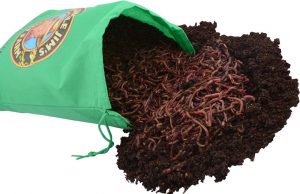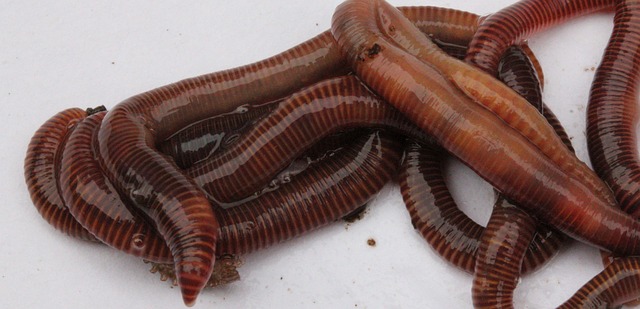How Many Worms Do I Need to Start a Worm Compost Bin?
Home › Garden › Composting ›
Calculate How Many Worms You Need to Start Your Worm Composter
For beginners we recommend starting with 1 pound of worms for every 4 square feet of your worm bin’s top surface area.
Experienced vermicomposters can start with more worms and we recommend 1 pound of worms for every 1 square foot of you worm composter’s top surface area.
Try out our worm density calculator below and carry on reading where we walk you through figuring out your personal composting requirements, the size of bin you need and the number of worms you want to start with.
When you buy products through the links on this site we may earn an affiliate commission. Learn more
Worm Density Calculator
Vermiculture experience level:
Internal measurements of your worm compost bin:
We Recommend:
Uncle Jim’s Worm Farm
Red Wiggler Composting Worms

Pros
- Guaranteed live delivery
- Free from pests, insects & mites
- Responsive customer service
What Is Your Composting Requirement?
The first question that you need to ask yourself before getting to the number of worms you need in your compost bin is what are your composting requirements.
Every person has different composting requirements, depending on how much waste is being produced by them and their family, or the number of plants that they have to use the compost on.
Other considerations extend to the size of the worm composting bins — which will be discussed in the next section — and the type of worms you are going to use. Here, we will be concentrating more on the amount of food and organic waste that is being produced by you and your family.
The best way of calculating the number of composting worms you need for your compost bin is by tracking the amount of vegetable food waste that you create with the help of a family food waste audit. This is very simple to carry out regardless of whether you are living alone or with other people.
First and foremost, you will be required to collect the amount of vegetable food waste that you create in a day, which could have otherwise been fed to your compost bin. This should include all the food waste that worms can ingest with ease, so avoid things like meats and dairy. Once you have collected all the scraps for the day, put them in a bag and weigh it using a kitchen scale. For one week, you will have to repeat the exercise every day and then take out the average of the results on the last day to know your total vegetable waste creation.
What Is the Size of Your Worm Bin?
Another factor that influences the number of worms that should be added to the worm bin is the size of the container itself.
The larger your bin’s surface area, the more worms you need to add to keep it in the best possible condition.
If you keep the temperature and moisture conditions right for the growth and subsistence of the worms and give them the right amount of food to eat, the worms will expand to incorporate the entire container that they have been poured into. As these worms work in the top inch of the compost pit, the size of the compost bin and the number of worms that are at work in it are intrinsically linked.
This means that the larger your bin’s surface area is, the more the number of worms you need to add to the bin to keep it in the best possible condition.
Usually, the ratio between the surface area and one pound of red wiggler worms — which are the most popular type of worms used for vermicomposting — is 1:1. Keep in mind that we will be going into further detail about how many worms are in a pound of red wigglers at a later point in this guide.
It is very easy to start a composting pit in a regular plastic storage box but if you need a larger composting pit, the number of worms will also have to be increased.
How Many Worms for Beginner Vermicomposters?
As a beginner who doesn’t have too much experience when it comes to vermicomposting, you may be more inclined towards depending on a fixed formula to determine how many worms should be added to your worm composting pit. To help you through this predicament, we have put together this guide that will help you reach the right number.
First and foremost, you will be required to answer the two important questions that have been mentioned earlier in this piece — how much food waste you produce on a regular basis and what is the size of the container in which you are setting up your composting pit.
With regards to the first question, the general consensus is that worms eat about 50% of their weight in food every day. Some research takes this amount even higher to approximately 100% of the worms’ body weight. Using a general figure here, it is safe to assume that one pound of worms will be consuming anywhere between 1.75 pounds to 2.45 pounds of food per week.
For beginners we recommend starting with 1 pound of worms for every 4 square feet as discussed in Mary Appelhof’s “Worms Eat My Garbage”. Her advice was first published in 1982 and has stood the test of time with new worm composters around the world.
Example
Let’s work this out using the VermiHut 5-Tray Bin as our example, which we think is the best budget worm compost bin.
The length and width of each VermiHut tray is 11.25 inches x 11.25 inches.
Using our worm density calculator we input our length and width, select the “beginner” option, and press calculate.
The worm density calculator has worked out that using Mary Appelhof’s “1 pound of worms to every 4 square feet of top surface area” rule we will need approximately 0.2 pounds of Red Wigglers to start 1 tray given that the top surface area of 1 tray is about 0.9 square feet.
If we wanted to start all 5 of the VermiHut’s trays we would need to times that number by 5 giving us 1 pound of worms to start our compost bin (0.2 pounds * 5 trays).
How Many Worms for Experienced Vermicomposters?
While most beginners prefer the “x lb of worms per sq ft” approach that is mentioned in the section above, as you gain more experience in vermicomposting and familiarize yourself with the functioning of the Red Wiggler worms that are most commonly used for the purpose of composting, you might find yourself feeling a little restricted by the method that was discussed earlier.
This does not take away from the validity of the approach, but if you are looking to change up the way in which you ascertain how many worms should be appropriate for your vermicomposting bin, it may be beneficial to add worm-rich material without worrying about putting in exact quantities.
As an experienced vermicomposter, you can allow the worm population of your bin to expand in a more natural manner depending on the resources that you have available. This also requires the addition of a lot of starter material that allows the worms to settle into the bin with greater ease.
While eyeballing the entire process may seem a little risky to beginners, experienced vermicomposters already have the necessary skills to use this “natural” approach to determining the right number of worms that need to be added to a composting bin.
To give you a good base to work with, a more experienced worm composter will probably want to use a less conservative ratio such as the “1 pound of worms to every 1 square foot of surface area” rule. So let’s work that out using an example.
Example
Using the Hungry Bin Continuous Flow-Through Vermicomposter which we rated the best overall worm composter you can see it has a top surface area of approximately 25 inches x 25 inches.
If you input these numbers into the worm calculator, click the experienced option, and click the calculate buttton it works out that your top surface area is 4.3 square feet and recommends you start with 4.3 pounds of worms!
Sources
Red Wiggler photo by Rob Hille [CC BY-SA 3.0], via Wikimedia Commons
Worms Eat My Garbage by Mary Appelhof



Buying worms based on square feet is misguided since food is more important than space. The worm population will adjust to the available food and space naturally. However, if you add too much food, it doesn’t matter the worm population because the food will decay to a mess before they consume your kitchen scraps. If you don’t have enough food for the population purchased they will die off to match the food resource. Additionally, having a low worm count in a large area leads to other problems.
Red Wigglers eat about half their body weight per day. If on average, you produce one pound of food scraps, you will need two pounds of worms. Now that you know the initial worm poundage construct a proper worm farm to match your food supply and worm population.
I have two two worm bins in the basement since they won’t survive our northern Ohio winter outside. One is a plastic bin approximately 15" wide x 24" long x 18" high. I add or remove the lid to control the moisture content. My second bin is a 5-gallon bucket with holes in the sides about 3" from the bottom. I started this bin with about a dozen worms from the larger bin. The population is growing.
Last, I have learned from experience that putting the kitchen scraps through a freeze/thaw cycle before adding them to the bin helps. This is not a requirement, but the freeze/thaw cycle jump-starts the decomposition process by bursting the cell walls. Worms don’t chew their food; they slurp it!
I hope everyone tries worm composting. It is lots of fun.
Just getting started. With my 360 worm. Put 2000 in it.